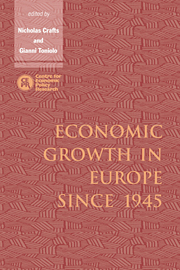Book contents
- Frontmatter
- Contents
- List of figures
- List of tables
- Preface
- List of contributors
- 1 Postwar growth: an overview
- 2 Institutions and economic growth: Europe after World War II
- 3 The varieties of Eurosclerosis: the rise and decline of nations since 1982
- 4 Why the 1950s and not the 1920s? Olsonian and non-Olsonian interpretations of two decades of German economic history
- 5 Convergence, competitiveness and the exchange rate
- 6 British economic growth since 1945: relative economic decline … and renaissance?
- 7 Economic growth in postwar Belgium
- 8 France, 1945–92
- 9 Economic growth and the Swedish model
- 10 Characteristics of economic growth in the Netherlands during the postwar period
- 11 Portuguese postwar growth: a global approach
- 12 Growth and macroeconomic performance in Spain, 1939–93
- 13 Irish economic growth, 1945–88
- 14 Italy
- 15 West German growth and institutions, 1945–90
- 16 An exercise in futility: East German economic growth and decline, 1945–89
- 17 Postwar growth of the Danish economy
- 18 Reflections on the country studies
- Index
15 - West German growth and institutions, 1945–90
Published online by Cambridge University Press: 04 August 2010
- Frontmatter
- Contents
- List of figures
- List of tables
- Preface
- List of contributors
- 1 Postwar growth: an overview
- 2 Institutions and economic growth: Europe after World War II
- 3 The varieties of Eurosclerosis: the rise and decline of nations since 1982
- 4 Why the 1950s and not the 1920s? Olsonian and non-Olsonian interpretations of two decades of German economic history
- 5 Convergence, competitiveness and the exchange rate
- 6 British economic growth since 1945: relative economic decline … and renaissance?
- 7 Economic growth in postwar Belgium
- 8 France, 1945–92
- 9 Economic growth and the Swedish model
- 10 Characteristics of economic growth in the Netherlands during the postwar period
- 11 Portuguese postwar growth: a global approach
- 12 Growth and macroeconomic performance in Spain, 1939–93
- 13 Irish economic growth, 1945–88
- 14 Italy
- 15 West German growth and institutions, 1945–90
- 16 An exercise in futility: East German economic growth and decline, 1945–89
- 17 Postwar growth of the Danish economy
- 18 Reflections on the country studies
- Index
Summary
Introduction
Popular perceptions of West German economic growth are polarized: either it is the miracle economy of the postwar era, the ‘strong-man’ of Europe, or it is a sclerotic economy, typifying Europe's inflexibility in labour and capital markets relative to the United States. One way of reconciling these apparently contradictory views is to depict West Germany as ‘the fading miracle’, as Giersch et al. (1992) have done. From this perspective, the miracle has long since gone and memories have lingered far behind the reality. But in Michel Albert's recent popular account of postwar capitalism (1993), Germany's reputation for dynamism and adaptability remains untarnished. One aim of this chapter is to put these contrasting interpretations into a longer-term and explicitly comparative perspective. Throughout, Germany's performance will be compared with that of the other three large European economies, the UK, France and Italy.
It is useful to begin by looking at attempts to identify a common OECD pattern of growth over the long run, and then at the extent to which West Germany fits this pattern. As a starting point, two such studies are used to provide a benchmark for the assessment of German growth. First is an endogenous growth model based on Scott (1989) and estimated by van de Klundert and van Shaik (1993; henceforth, KS) for a group of eight OECD economies from 1870, extended to sixteen for the postwar period. The second study is that of Dowrick and Nguyen (1989; henceforth, DN) which is a Solow-type model with exogenous technical progress, augmented with catch-up estimated for a group of twenty-four OECD countries for the postwar period.
- Type
- Chapter
- Information
- Economic Growth in Europe since 1945 , pp. 455 - 497Publisher: Cambridge University PressPrint publication year: 1996
- 52
- Cited by



